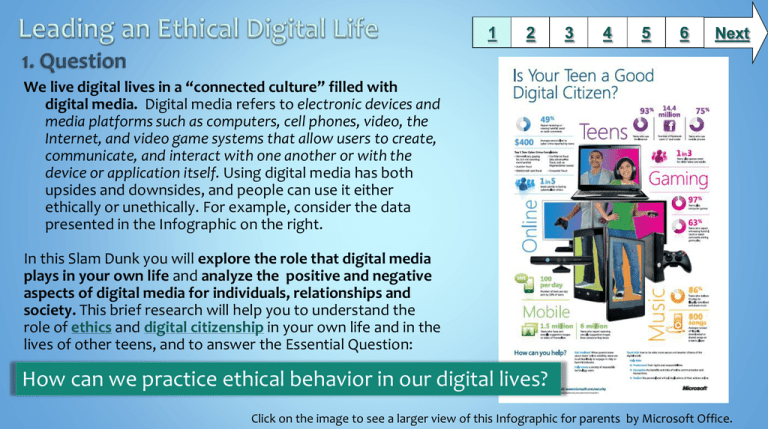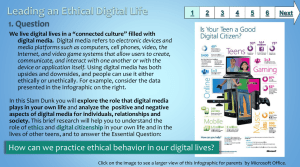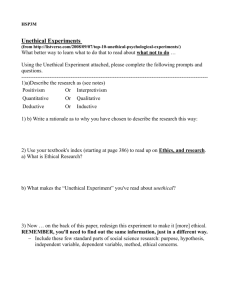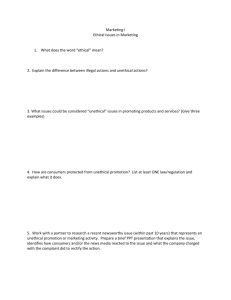
1
2
3
4
5
6
Next
We live digital lives in a “connected culture” filled with
digital media. Digital media refers to electronic devices and
media platforms such as computers, cell phones, video, the
Internet, and video game systems that allow users to create,
communicate, and interact with one another or with the
device or application itself. Using digital media has both
upsides and downsides, and people can use it either
ethically or unethically. For example, consider the data
presented in the Infographic on the right.
In this Slam Dunk you will explore the role that digital media
plays in your own life and analyze the positive and negative
aspects of digital media for individuals, relationships and
society. This brief research will help you to understand the
role of ethics and digital citizenship in your own life and in the
lives of other teens, and to answer the Essential Question:
How can we practice ethical behavior in our digital lives?
Click on the image to see a larger view of this Infographic for parents by Microsoft Office.
1
2
3
4
5
6
Next
Use these sources and other reliable sources you find
to gather information about digital life and ethics,
including:
Some upsides (positive aspects or benefits) and
downsides (negative aspects or problems) of digital
media and living in a connected culture for
individuals, relationships and society.
Examples of ethical and unethical behavior
in the digital world.
Use this chart to make a note of main ideas, important
details, and key terms/definitions.
The Definition of Digital Citizenship
What is CyberEthics?
What is Cyber Crime?
Practice Cyberethics
10 Commandments of Computer Ethics
BCPS Technology Acceptable Use Policy
Use Destiny WebPath Express or a BCPS-licensed
datatbase to locate additional reliable sources.
In this video, teens of all ages discuss the benefits and
disadvantages of the Internet. Source: Common Sense Media
1
2
3
4
5
6
Next
Take this QUIZ to see how much you know about
the digital lives of teens as a group. Use the
Answer Key to check your answers. Discuss
with a partner or small group which answers
surprised you the most, and which answers
were the closest to or farthest from your own
experiences with digital media.
Discuss how the information presented in the
Infographics on the right and on Slide 1
compares to your own digital life.
Use the notes from your brief research on Slide 2
to discuss with your classmates:
Some upsides (positive aspects or benefits)
and downsides (negative aspects or problems)
of digital media and living in a connected culture
for individuals, relationships and society.
Examples of ethical and unethical behavior in
the digital world.
Image Source: Statista.com
1
2
3
4
5
6
Next
1. Use your new knowledge to show what you know about digital media and living in a connected culture.
2. Contribute one example each of ethical and unethical behavior in the digital world to create a class list, which
could be displayed as poster in your school or posted on the school Website.
3. Create a simile to express the role digital media plays in your life.
First, reflect on these questions to jot down some brief responses in preparation for writing your simile:
How big a role do digital media (Internet, texting, video games) play in your life (a little, some, a lot)?
What are your favorite and least-favorite things to do with digital media?
Do you connect with others or create things with digital media?
What are the “upsides” and “downsides” (positive and negative aspects) of having digital media in your life?
Create your simile by completing one of the following statements in a way that captures and conveys the role of
digital media in your life. Then share your simile with your classmates.
My digital life is like a ____________________, because ___________________________________.
My digital life is as ______________________as a ________________, because ________________.
Sample similes:
My digital life is like a window onto the world, because it allows me to see all kinds of new things and imagine other possibilities.
My digital life is like a party where I meet a lot of different people, because it feels loud, out of control, and yet fun.
My digital life is as tempting as junk food, because I don’t always know when to say no.
Optional:
Make a collage illustrating your simile using words and images you draw yourself, cut from magazines, create using a digital drawing
tool, or copyright-friendly images found online. You could also animate your simile using a digital tool like Pencil or Animoto.
1
2
3
4
5
6
Next
Check out the 2014/2015 Winners
of Trend Micro’s What’s Your
Story? Video Contest, where
teens created videos to answer
the question: What does the
good side of the Internet look
like?
Image Source: http://whatsyourstory.trendmicro.com
Check back on TrendMicro’s
What’s Your Story? Website to
see when they plan to run a new
contest, or look for other digital
citizenship video contests to
enter!
1
2
3
4
5
6
Digital Citizenship: High School
Time Frame: 1-2 class periods
Maryland Technology Literacy Standards
Standard 2.0 Digital Citizenship: Demonstrate an understanding of the history of technology and its impact on
society, and practice ethical, legal, and responsible use of technology to assure safety.
Common Core State Standards
Reading: 1. Read closely to determine what the text says explicitly and to make logical inferences from it; cite specific
textual evidence when writing or speaking to support conclusions drawn from the text.
Writing: 7. Conduct short as well as more sustained research projects based on focused questions, demonstrating
understanding of the subject under investigation.
Standards for the 21st Century Learner
1.1.6 Read, view, and listen for information presented in any format (e.g. textual, visual, media, digital) in order to
make inferences and gather meaning.
2.1.3 Use strategies to draw conclusions from information and apply knowledge to curricular areas, real-world
situations, and further investigations.
3.1.4 Use technology and other information tools to organize and display knowledge and understanding in ways that
others can view, use, and assess.
3.1.6 Use information and technology ethically and responsibly.
ISTE Standards for Students
1. Creativity and innovation: Students demonstrate creative thinking, construct knowledge, and develop innovative
products and processes using technology. a. Apply existing knowledge to generate new Ideas, products, or
processes. b. Create original works as a means of personal or group expression
3. Research and Information Fluency: Students apply digital tools to gather, evaluate, and use information.
b. Locate, organize, analyze, evaluate, synthesize, and ethically use information from a variety of sources and media.
4. Critical Thinking, Problem Solving, and Decision Making: Students use critical thinking skills to plan and conduct
research, manage projects, solve problems, and make informed decisions using appropriate digital tools and
resources. c. Collect and analyze data to identify solutions and/or make informed decisions.
5. Digital Citizenship: Students understand human, cultural, and societal issues related to technology and practice
legal and ethical behavior. 5a. Advocate and practice safe, legal, and responsible use of information and technology.
Differentiation strategies for this lesson:
Direct students to use learning tools included in our
BCPS-licensed databases, such as: audio read-aloud,
labeled reading levels/Lexiles, and embedded
dictionaries.
Multiple media formats enable all learners to be
engaged.
Students can complete with a partner or small group.
Notes to the teacher:
Collaborate with your school library media specialist to
implement this Slam Dunk lesson.
Consider having students post/publish their class list of
examples of ethical/unethical behavior in the digital world,
their similes, or other creative work they produce, with the
school community or a wider audience.
For supplemental materials and Answer Keys, see this
Common Sense Media Lesson Plan: Digital Life 102 (Grades
9-12/Unit 1) , from which elements of this Slam Dunk lesson
have been used or adapted.
Last updated: August 2015
Created by Kelly Ray, Resource Teacher – BCPS Office of Digital Learning
BCPS Slam Dunk Research Model, Copyright 2014, Baltimore County Public Schools, MD, all rights reserved. The models may be used for educational, non-profit school use only.
All other uses, transmissions, and duplications are prohibited unless permission is granted expressly. This lesson is based on Jamie McKenzie’s Slam Dunk Lesson module.









